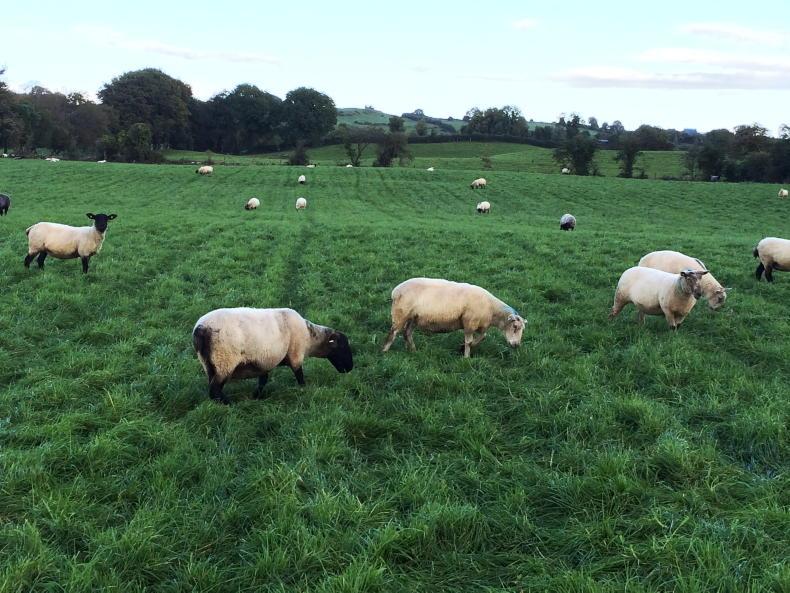Grazing plans: The majority of sheep farms find themselves in a good position regarding grass supplies after a few weeks of excellent grass growth.
There are some farms in pockets of the east which suffered from prolonged drought and low rainfall levels.
These farms do not have the same surplus of grass as those in the western half of the country, but should hopefully be helped by the potential for higher grass utilisation on dry soils.
Surplus grass is to be welcomed at this stage of the year, with quality typically holding for longer and the potential to carry ewes for longer into the winter.
This position does come with a risk of challenges in getting paddocks grazed off sufficiently and closed for spring grazing.
Philip Creighton, Teagasc, advises that farmers should now be assessing the volume of grass present and questioning if autumn grazing plans need to be tweaked to stay on course. For example, where heavy covers have developed on the paddocks earmarked for closing early, these may need to be grazed as soon as possible while grass utilisation is favourable and there is more scope to get a good clean-out or to allow an opportunity to graze now, freshen up and then return for a final grazing. Teagasc advice on closing targets for flocks operating a midseason lambing enterprise at a medium-to-high stocking rate (10 to 12 ewes per hectare) is to have 20% of the farm closed by late October, 40% by mid-November, 60% by late November and 80% by mid-December. This will typically provide a rest period of 120 days, giving paddocks first closed an opportunity to have a reasonable cover of grass on swards while growth is still relatively good.
Grazing heavy covers: While not always practical, the ideal approach in grazing out heavy covers is to split the available area into two- to three-day grazing blocks. In this situation, ewes will be forced to graze lower-quality material for a shorter period before returning to better-quality grass.
This can be achieved by increasing the size of the grazing group or splitting paddocks temporarily. In terms of allocating grass, ewe intake requirements will be in the region of 1.5kg to 1.6kg DM/ha in the runup to and during breeding. This will reduce closer to 1.3kg DM/ha later in the season or for early lambing ewes in mid-pregnancy. Where ewes are being allocated a greater area, then they should not be forced to graze out lower-quality material in the runup to breeding or during breeding and return at a later stage when their nutritional requirement has eased. Table 1 details the number of grazing days for a range of grass covers based on 100 ewes grazing a 1ha plot and offered 170kg DM/day.
Utilisation is currently good, but if this changes, ewes will need to be allocated a higher volume of grass or moved more regularly to maintain performance.
Grazing plans: The majority of sheep farms find themselves in a good position regarding grass supplies after a few weeks of excellent grass growth.
There are some farms in pockets of the east which suffered from prolonged drought and low rainfall levels.
These farms do not have the same surplus of grass as those in the western half of the country, but should hopefully be helped by the potential for higher grass utilisation on dry soils.
Surplus grass is to be welcomed at this stage of the year, with quality typically holding for longer and the potential to carry ewes for longer into the winter.
This position does come with a risk of challenges in getting paddocks grazed off sufficiently and closed for spring grazing.
Philip Creighton, Teagasc, advises that farmers should now be assessing the volume of grass present and questioning if autumn grazing plans need to be tweaked to stay on course. For example, where heavy covers have developed on the paddocks earmarked for closing early, these may need to be grazed as soon as possible while grass utilisation is favourable and there is more scope to get a good clean-out or to allow an opportunity to graze now, freshen up and then return for a final grazing. Teagasc advice on closing targets for flocks operating a midseason lambing enterprise at a medium-to-high stocking rate (10 to 12 ewes per hectare) is to have 20% of the farm closed by late October, 40% by mid-November, 60% by late November and 80% by mid-December. This will typically provide a rest period of 120 days, giving paddocks first closed an opportunity to have a reasonable cover of grass on swards while growth is still relatively good.
Grazing heavy covers: While not always practical, the ideal approach in grazing out heavy covers is to split the available area into two- to three-day grazing blocks. In this situation, ewes will be forced to graze lower-quality material for a shorter period before returning to better-quality grass.
This can be achieved by increasing the size of the grazing group or splitting paddocks temporarily. In terms of allocating grass, ewe intake requirements will be in the region of 1.5kg to 1.6kg DM/ha in the runup to and during breeding. This will reduce closer to 1.3kg DM/ha later in the season or for early lambing ewes in mid-pregnancy. Where ewes are being allocated a greater area, then they should not be forced to graze out lower-quality material in the runup to breeding or during breeding and return at a later stage when their nutritional requirement has eased. Table 1 details the number of grazing days for a range of grass covers based on 100 ewes grazing a 1ha plot and offered 170kg DM/day.
Utilisation is currently good, but if this changes, ewes will need to be allocated a higher volume of grass or moved more regularly to maintain performance.






 This is a subscriber-only article
This is a subscriber-only article











SHARING OPTIONS: